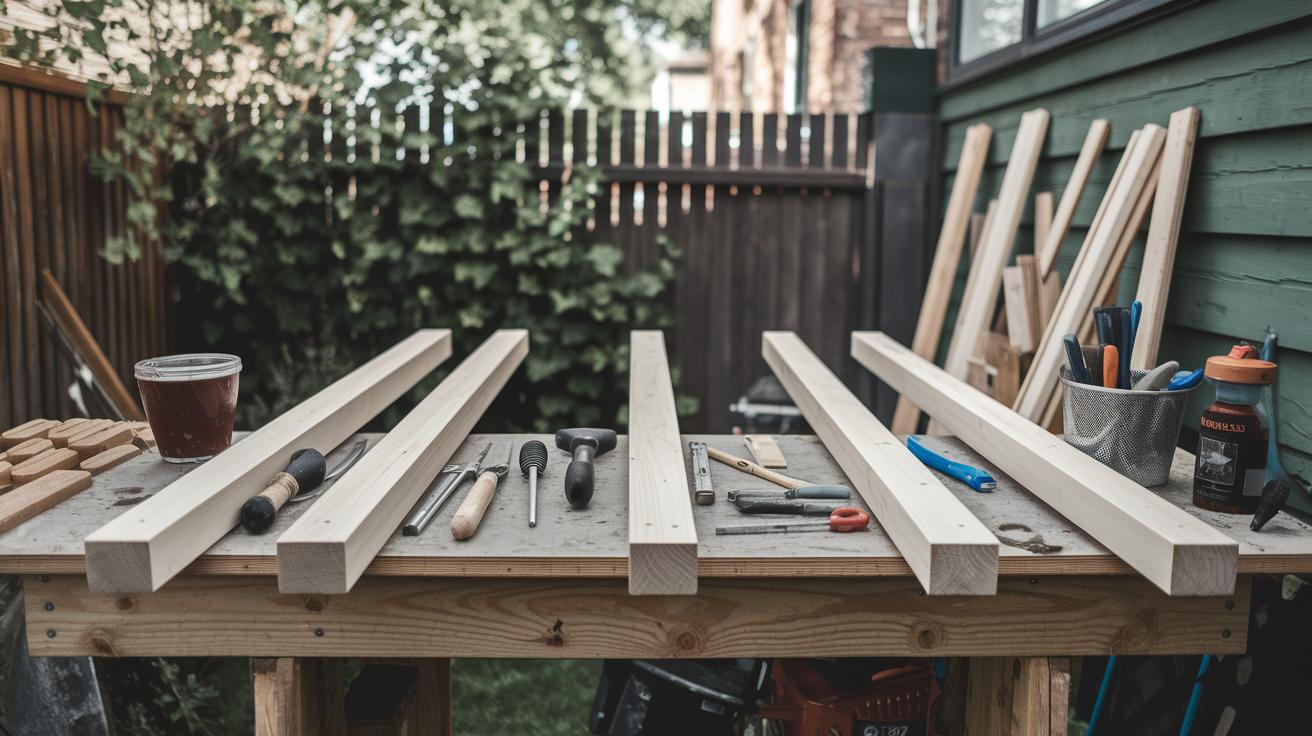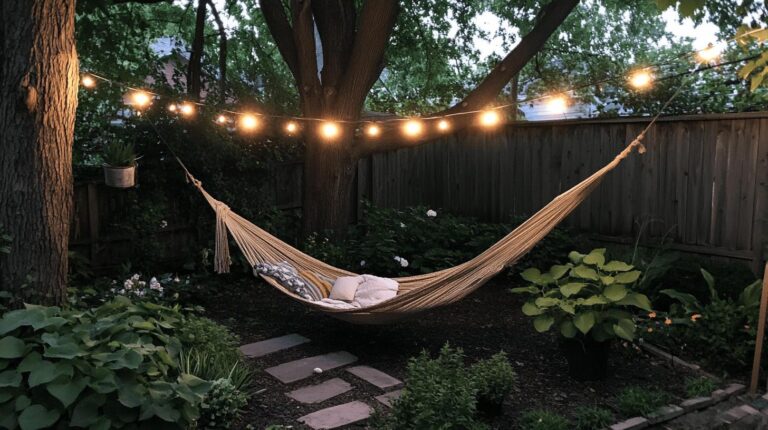Garden Hammock Frame Plans For Pallet Wood Affordable
Ever thought a garden hammock would wipe out your savings? Think again. You can turn reclaimed pallet wood (wooden shipping platform) into a rock-solid frame for less than fifty bucks. It takes about four to six hours – and you only need simple tools like a hammer and saw.
Picture this: the sun-warmed wood under your fingertips. You smell sawdust drifting in the breeze, you know, as you run sandpaper over each plank. Feels pretty nice, right?
We’ll walk you through every step. First, hunt down solid pallets at a local shop or farm. Then carefully pull out the rusty nails – watch your fingers!
Next, sand all the rough spots until the boards feel silky smooth. Add simple braces to keep the frame steady. Finally, seal the wood with a weatherproof coat to guard against rain and sun.
Before you know it, you’ll be swaying in your own backyard hideaway.
At a Glance: Eco-Friendly Pallet Wood Hammock Frame Under $50
Thinking of a garden hammock? You can build a sturdy frame from reclaimed pallet wood (wooden shipping platform) for under fifty bucks. It only takes about 4–6 hours. Picture the warm sun, the faint scent of sawdust, and the comfort of smooth boards under your hands.
First, pick pallets with solid boards. Then pry them apart, watch for rusty nails. Have you ever smelled fresh pine in the sun? Oops, I once nicked a finger, so wear gloves.
Cut each board and sand until smooth. It feels nice between your fingers. And you’ll notice the soft hum of your sander in the background. Lock everything together with metal braces for extra strength.
Now it’s time to weatherproof. Brush on a clear, garden-safe sealant or stain. You’ll love how the color deepens and the wood glows. Wait a day for it to dry before testing your frame.
Seasonal care is simple. Reapply sealant once a year. Shake off leaves and wipe the frame clean in spring. Plant some vines nearby to help shade and show it off.
Jump to each section below for step-by-step instructions:
- Essential Materials and Tools
- Preparing Pallet Wood
- Assembling the Pallet Wood Garden Hammock Frame
- Stability and Safety Considerations
- Finishing and Weatherproofing
- Seasonal Maintenance Tips
Essential Materials and Tools for Pallet Wood Garden Hammock Frame

I always start with reclaimed pallet wood (old shipping wood). I look for straight, long boards without rot (wood that’s breaking down) or little holes from bugs. I run my hand over each plank. If it feels soft or you see cracks, set it aside. A tight grain (close wood lines) feels firm under your fingertips. That gives you a solid base for your hammock frame.
Here’s what you’ll need for this outdoor furniture project:
- A pry bar and hammer to pull boards apart without splitting them
- A circular saw or handsaw to trim the boards to the right length
- A power drill with driver bits for pilot holes (small starter holes) and screws
- A sander or a stack of sandpaper (80-grit for rough, 120-grit for smooth)
- A carpenter’s level to keep your posts plumb (straight up and down)
For hardware and finishing touches:
- High-grade wood screws or bolts rated to hold 250 to 300 pounds
- Washers and nuts for extra grip and tight joints
- Metal brackets to brace the frame and stop it from swaying
- Weatherproof sealant (waterproof coating) or outdoor paint to shield the wood from sun and rain
If you already own the basic tools, all the screws, sealant, and brackets usually cost under fifty dollars. That makes this project easy on your wallet and good for the planet.
Preparing Pallet Wood for Garden Hammock Frame
First, haul your pallet wood (recycled wooden planks) into bright light. Run your hand over each board to feel for soft spots where the wood’s breaking down, little cracks, loose grain, or tiny bug holes. Boards that give under your fingertips or look rotten? Set them aside.
Now, let’s free those good planks without smashing them. And yes, I once spilled a pile of splinters thinking I was in a rush. Oops.
- Use a pry bar (that long metal lever) and a hammer to lift each board inch by inch. Go slow so the wood doesn’t split as you wiggle it from the pallet frame.
- Pull out nails and staples with a nail puller (claw tool) or sturdy pliers. Work carefully, nobody wants bent nails or pinched fingers.
- Measure twice and cut once. Mark both ends of each plank with your pencil before trimming so every piece matches your hammock frame blueprint.
- Sand each board in two stages. Start with 80-grit sandpaper (coarse) to knock down rough spots and old paint flakes. Then switch to 120-grit (fine) for a smooth finish that won’t snag your hammock straps.
By the way, my cat tried to inspect every plank, just a heads-up if you have a curious kitty. Back to prepping your wood: once you’ve pulled, cut, and sanded, you’ll have sturdy, straight boards ready to build a cozy garden hammock frame.
Assembling the Pallet Wood Garden Hammock Frame

Lay out your cut and sanded boards on a flat surface. I like to spread them across my work bench so I can run my hand over the smooth edges. Grab a tape measure and mark where you’ll stand four vertical posts that are each about 6 feet tall. I often sketch chalk lines on the floor so I can just plop each post right on its spot. Oh, and double check that your ground is level. Nothing bugs me more than a wobbly frame.
Positioning the Vertical Posts
Set each 6-foot post on its chalk mark. Slide your level (tool that shows if something is flat) against the side. When the bubble sits snug between the lines, clamp on a temporary brace so the post won’t wobble. After you bolt it in, give it another quick level check. All good? Move on to the next one.
Attaching Horizontal Beams
Place a 10- to 12-foot beam between two posts, lining it up at the top first and then the bottom. Use a pencil to mark pilot hole spots about 2 inches from each end. A pilot hole (a small starter hole) keeps the wood from splitting when you add screws. Drill your starter hole, then drive in outdoor-grade wood screws or bolts. Space these beams about 4 to 5 feet apart for a sturdy base. If you like, add metal corner brackets at each beam-post joint for extra holding power.
Installing Diagonal Bracing
Now let’s secure your frame with diagonal braces. Cut each brace at a 45-degree angle so it fits snug between a post and a beam. Fasten both ends with metal brackets and screws. Tighten each bolt until everything feels snug and secure. Then check each corner with your level and a carpenter square (tool for right angles). Once it’s rock solid, step back and admire the sturdy cradle you’ve built!
Stability and Safety Considerations for Pallet Wood Garden Hammock Frames
Before you climb in, check that your screws, bolts and brackets can hold at least 250 to 300 pounds.
Try a gentle bounce test. Give the frame a light jiggle and listen for creaks or feel any wobble. This helps you spot weak spots before settling in.
Flip back to the “Assembling the Pallet Wood Garden Hammock Frame” section for tips on leveling the posts, setting it up on flat ground and adding diagonal braces.
Safety gear to grab first:
- Safety glasses (to block flying wood chips)
- Work gloves (to shield your hands from splinters)
- Dust mask (to keep sawdust out of your lungs)
I once skipped the glasses and ended up with a wood chip near my eyebrow. Oops.
If your soil feels soft like a sponge, drive spike anchors (long metal rods) right beside each post. Slip an eye bolt through the anchor and tighten it until the frame sits snug. This ground-anchor trick keeps your hammock from tipping, even when a breeze rustles the leaves.
Solid anchors mean a steady sway.
But remember, safety first, because that hammock moment should be all about relaxing, not worrying.
Finishing and Weatherproofing Your Pallet Wood Garden Hammock Frame Plans

Grab some 120-grit sandpaper (paper with fine rough bits). Run it over every beam joint, surface, and bracket spot. This light sanding helps coatings stick. Go slow around corners. Oops, I once skipped a spot and saw stain flake off later. Lesson learned.
Now your frame is nice and smooth. Time to shield it from rain, sun, and pesky insects. Pick a high-quality weatherproof sealant (a paint-like layer that stops water damage) or an outdoor stain. If your sun is strong, grab a UV-resistant sealant. Want extra water defense? A marine-grade varnish adds that layer. For an eco-friendly build, choose a water-based preservative (plant oils, low odor).
You can:
- Apply a weatherproof sealant to all surfaces, brushing with the grain (the lines in the wood).
- Recoat with an outdoor stain that soaks in and repels moisture.
- Use a UV-resistant sealant for sun protection.
- Add a marine-grade varnish for extra water defense.
- Try a water-based, eco-friendly preservative for low-odor finishing.
Wait 24 to 48 hours between coats. Two coats usually do the trick for lasting defense. Let each layer dry fully, then gently sand with fine paper before the next coat.
Your hammock frame is now weatherproofed and ready to last.
Seasonal Maintenance Tips for Pallet Wood Garden Hammock Frames
Hey there. Before you settle into your hammock each season, give the frame a quick look. It only takes a few minutes and keeps you safe.
-
Inspect screws or bolts once a year. Grab a screwdriver or wrench and snug each one up. Oops, one time I found a bolt almost spun free. Yikes.
-
Reapply weatherproof sealant (protective coating) or stain every 12 months or whenever little water drops stop beading on the wood’s surface. That thin layer keeps moisture out and gives the wood a fresh, woodsy scent.
-
Scan each board for soft spots, cracks, or tiny bug holes. See any rot (wood breaking down) or insect damage? The wood might feel spongy or look pockmarked. Swap in a fresh board before it gets worse.
-
In fall, wipe away crunchy leaves, dust, and pollen with a soft cloth. You’ll feel the wood smooth again and help air flow so dampness doesn’t sneak in.
When winter rolls in, tuck the frame indoors if you can. No garage? Drape a waterproof tarp over it, loose enough for air to breathe so your wood won’t trap dampness.
Need more tips? Check out the garden hammock cleaning and maintenance guide for a deeper dive into year-round care.
Final Words
In the action: you’ve taken rough pallet planks and turned them into a snug hammock hangout for less than fifty bucks and about a half-day build.
You picked pallets, pried and sanded each board, then bolted posts, beams, and braces into a rock-solid frame.
Grab a weatherproof sealant, let it dry, and your sturdy frame resists sun and rain.
With a quick annual check and a fresh coat of finish, you’ll keep enjoying lazy afternoons swinging. Happy building your garden hammock frame plans for pallet wood.
FAQ
How much does a pallet wood hammock frame cost to build?
The pallet wood hammock frame costs under $50 using reclaimed pallet boards, screws, brackets, and sealant, assuming you already own a pry bar, saw, drill, and sander.
How long does it take to build a garden hammock frame?
The build takes about 4–6 hours from pallet selection and dismantling to assembly, sanding, and weatherproofing, so you can relax in your garden by day’s end.
What materials and tools do I need for the project?
You need straight, crack-free pallet boards, high-grade wood screws or bolts with washers, metal brackets, a pry bar, hammer, saw, drill with bits, sander or sandpaper, carpenter’s level, and weatherproof sealant.
How do I prepare reclaimed pallet wood for the frame?
To prep pallet wood, inspect boards for damage, use a pry bar and hammer to remove planks, pull nails, cut boards to length per blueprint, then sand with 80-grit followed by 120-grit paper.
How is the frame assembled for stability?
Frame assembly means setting four vertical posts plumb, attaching top and bottom beams with pre-drilled pilot holes, then adding 45° diagonal braces with brackets to reduce sway and keep the structure square.
What weight can the hammock frame hold and what safety gear should I use?
The hammock frame holds 250–300 pounds when built with high-grade screws or bolts and diagonal bracing. Wear safety glasses, work gloves, and a dust mask during cutting and sanding.
How do I protect the pallet wood frame from weather?
Protect the frame by sanding joints and surfaces, then apply two coats of outdoor-grade stain or weatherproof sealant, letting each coat dry 24–48 hours to block moisture and UV damage.
What seasonal maintenance does the garden hammock frame need?
Seasonal maintenance means checking and tightening fasteners, reapplying sealant when water stops beading, inspecting for rot or insect damage, and covering or storing the frame indoors during winter.







